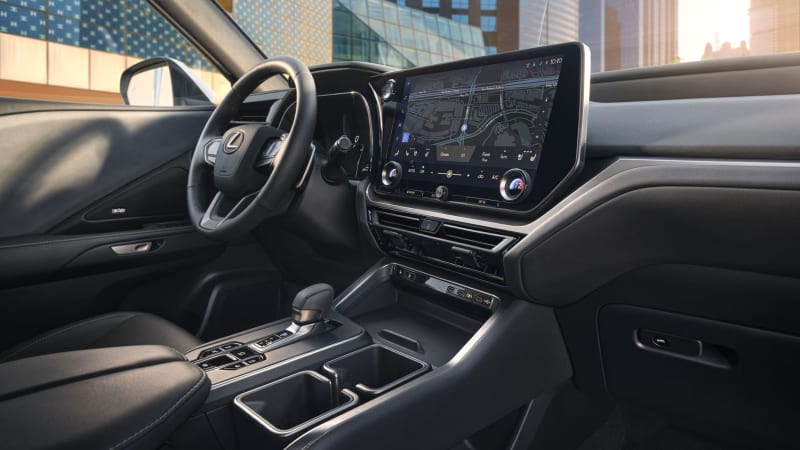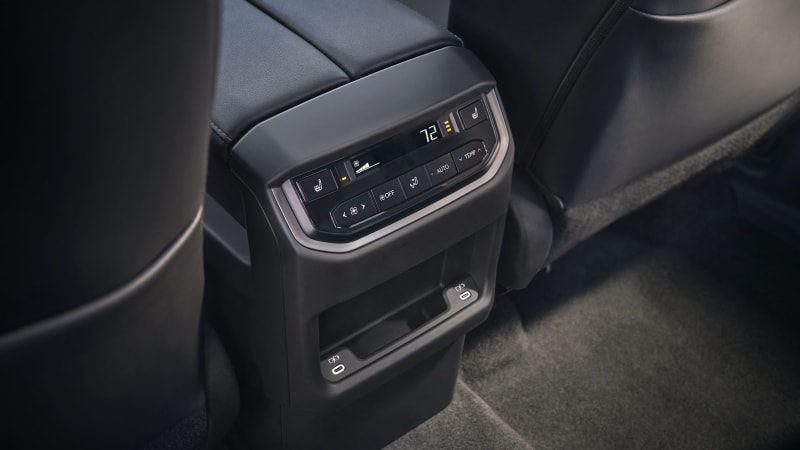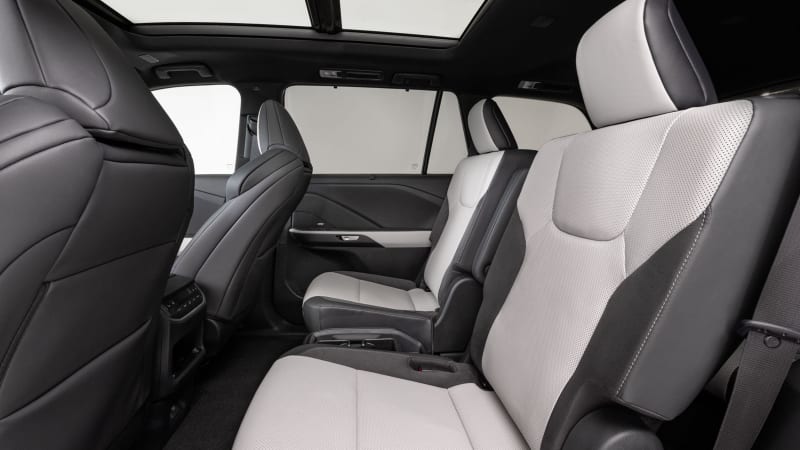Part II of the Lexus “Double Feature” this week is the 2024 TX — a brand-new model based on the mainstream Toyota Grand Highlander that gives Lexus its first legitimate three-row family crossover. While it may be a Toyota underneath, the new TX puts a luxury spin on the people-hauler formula befitting its premium aspirations, and from our first glance at the specs, it appears to offer a little something for everybody.
Measuring just over 203 inches long and riding on a 116-inch wheelbase, the TX is on the long end of midsize, slotting in nicely between the Audi Q7 (199 inches) and the Mercedes-Benz GLS (205). It rides on a multi-link suspension and comes with one of three powertrains: a 2.4-liter turbo-four (TX 350), a hybrid based on the same (TX 500h) and then a plug-in hybrid based on Toyota’s 3.5-liter V6 (TX 550h+).
The turbocharged four-pot can be had with either FWD or AWD (both hybrids come with standard all-wheel drive) and produces 275 horsepower and 317 pound-feet of torque (better than Highlander because it was rated on premium fuel) with a projected EPA combined rating of 21 miles per gallon. Stepping up to the standard hybrid bumps those numbers to 366 hp and 409 lb-ft, good for 24 mpg. Then there’s the PHEV. Check this: 406 horsepower (and an unspecified torque figure) with 30 mpg combined and 33 miles of EV-only range. The downside is that it’s the only powertrain here to incorporate a CVT, but this is clearly not your momma’s Highlander.
Building on that theme, Lexus is offering the 2.4-liter hybrid powertrain exclusively as an F Sport Performance model that borrows powertrain and chassis tech from the RX. The standard AWD system is augmented with Toyota’s DRS rear-steer system, which turns the rear wheels to either match or oppose the direction of the front wheels to improve stability at speed or maneuverability in tight spots, respectively. Lexus engineers didn’t have the maximum rear steering angle figure on hand, but noted that the TX utilizes it far more liberally than the RX to help compensate for its extra length and wheelbase. This is also the only TX with an adaptive suspension setup, which is something we’ve come to expect from F Sport Performance models.
So, why is the honkin’ V6 PHEV not getting the F-Sport treatment? In a word: luxury. Lexus TX Chief Engineer Naohisa Hatta told Autoblog that refinement, cabin noise and linear power delivery prompted them to put the V6 in the TX’s most luxurious trim. The enthusiasts should opt for the 2.4-liter hybrid F-Sport Performance model if they prioritize dynamics. It’s the only variant available with adaptive suspension and. As an added bonus, the six-speed auto in that combination should be a lot more palatable than the 550h+’s CVT.



The interior is spacious and packed with conveniences. The front center console features a dual lid (split front-to-back) that allows either the driver or passenger to open only their side independently if desired. A modular second-row console is also available on models equipped with captain’s chairs; a second-row bench is standard. Lexus claims there’s 20.1 cubic feet of cargo room behind the third row — besting both the Audi and Mercedes-Benz we mentioned previously. That jumps to 57.4 cubes with the third row folded flat and 97 cubes with all of the rear seats stowed. A one-touch button on the second row seats flips them for easy access to the rear.
If you’re familiar with the latest from Toyota and Lexus, you’ll recognize the company’s new 14-inch infotainment system. It’s standard here, along with wireless Apple CarPlay and Android Auto. A 12.3-inch cluster display is available; the standard screen’s dimensions were not available at the time of publication. Also standard is Lexus Safety System+ 3.0, which includes advanced driver aids such as adaptive cruise control, lane keeping assist and blind spot monitoring, among others.
The TX is the first new Lexus vehicle to be assembled at the company’s Indiana plant. Both the TX 350 and TX 500h should hit showrooms this fall, while the 550h+ will come later, potentially next year as a 2025 model. Stay tuned.
[ad_2]
Source link







